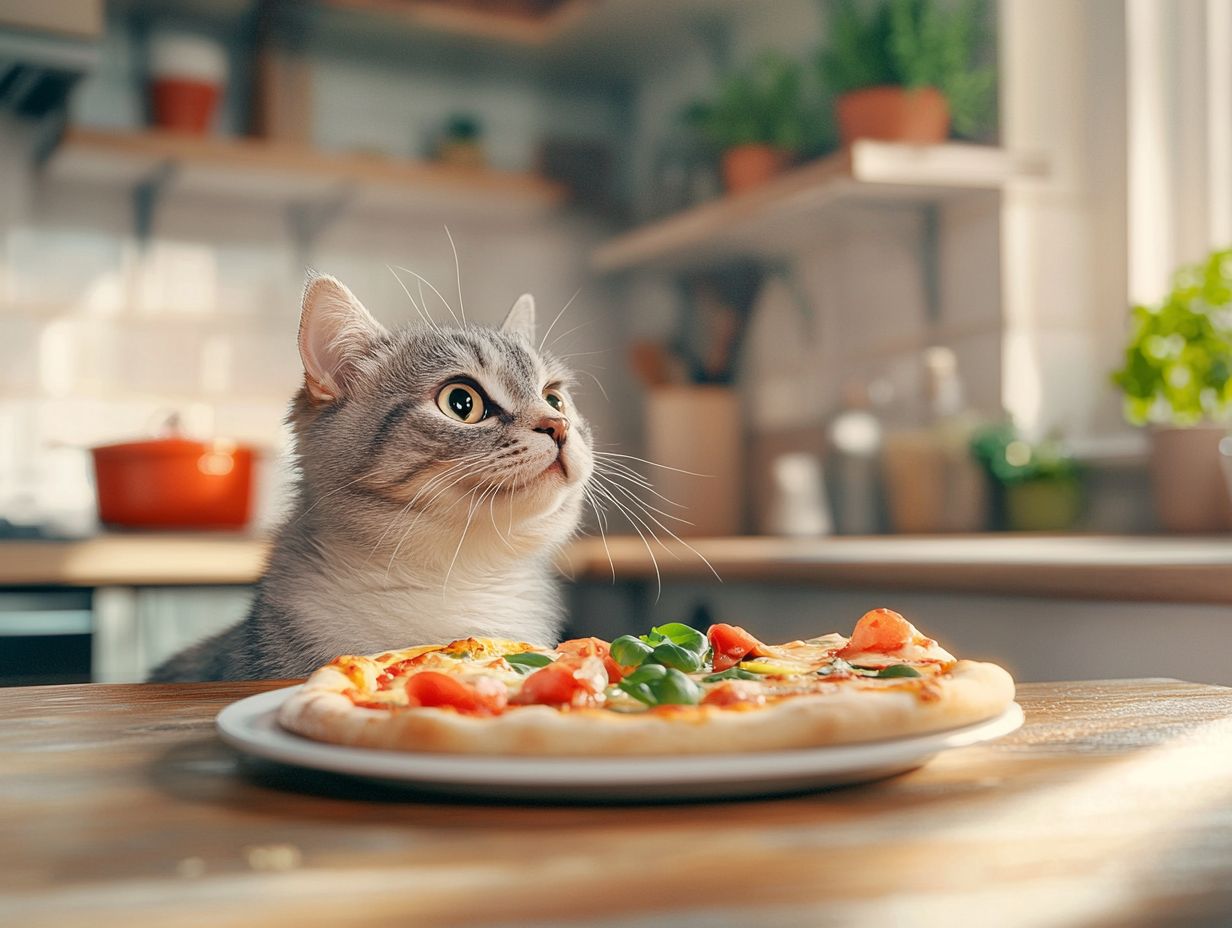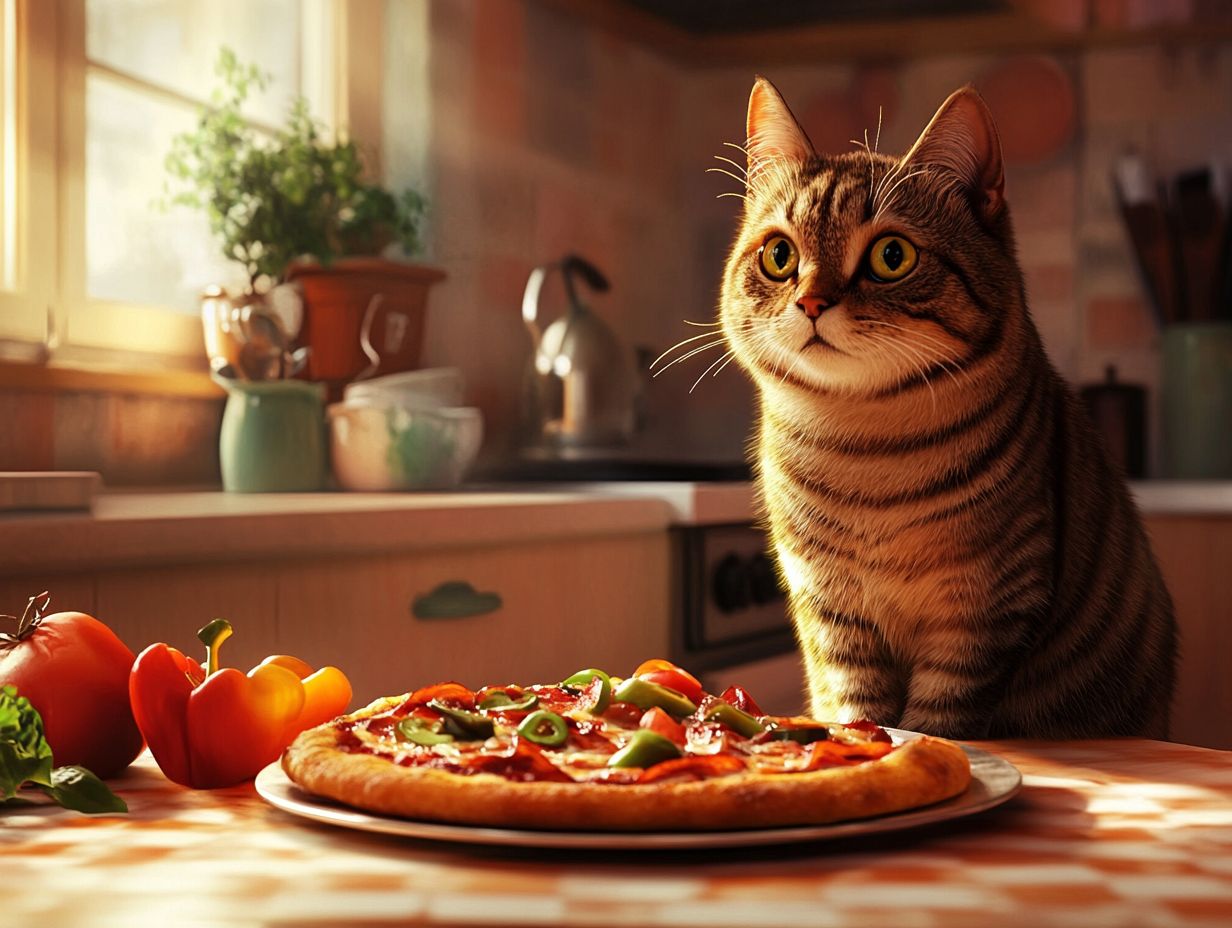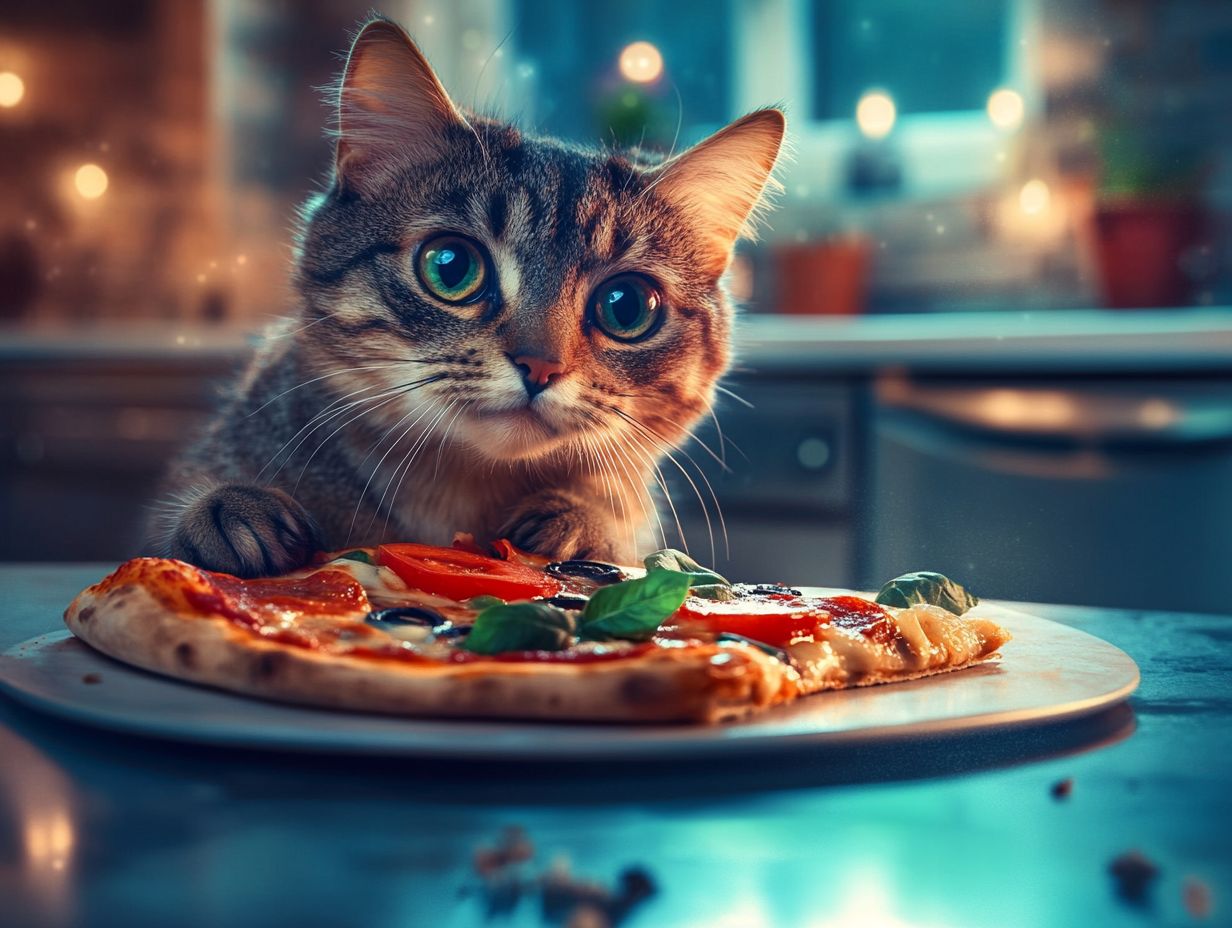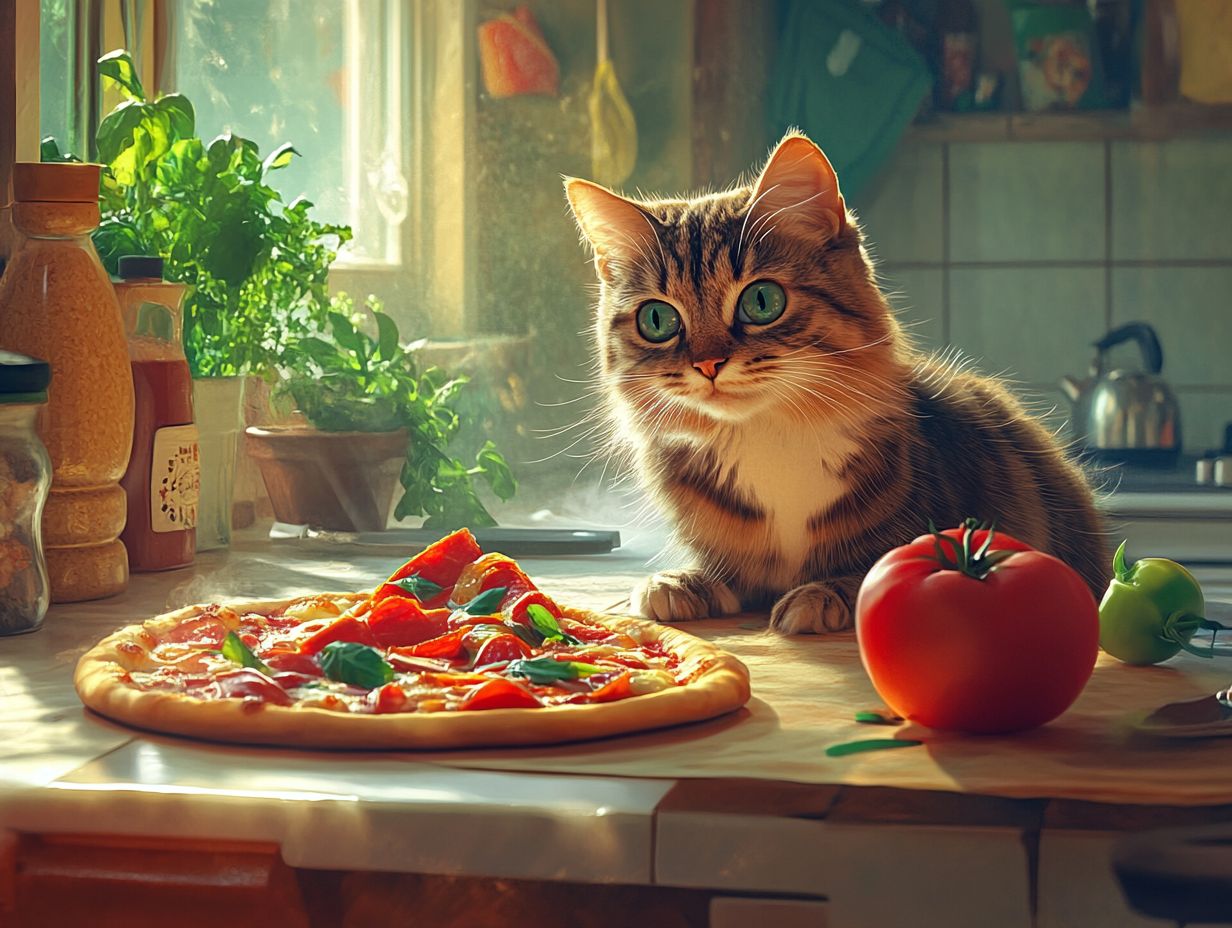While sharing a slice of pizza may seem tempting, it’s crucial to understand that pizza does not meet a cat’s nutritional needs and can pose serious health risks.
This article discusses the potential health risks, such as toxicity from garlic and onions and digestive upset from high-fat ingredients like cheese. We will also explore healthier treat alternatives and offer tips for safely sharing pizza without compromising your cat’s well-being.
Join us for insights that will keep your kitty happy and healthy!
Key Takeaways About Pizza and Cats:

- Feeding pizza to cats is not recommended due to potential health risks.
- Avoid ingredients like garlic, onion, and excessive cheese, which can be toxic or unhealthy.
- Choose healthy alternatives like cooked chicken or fish as treats.
Is Pizza Safe for Cats?
Let’s explore the safety of pizza for our feline companions. Pizza is a popular food among humans, but its safety for cats is mixed due to various ingredients like pepperoni and dough that could be harmful to them.
While you might be tempted to share a slice with your cat, it’s important to remember that cats are carnivores, meaning their nutritional needs differ significantly from those of humans. Additionally, their digestive systems are not designed to handle many of the foods commonly found in pizza.
Consulting a veterinarian or resources like PangoVet and the Pet Poison Helpline can help you understand which types of treats are suitable for cats, ensuring they remain both healthy and happy.
Understanding a Cat’s Nutritional Needs
A cat’s nutritional needs are crucial because their diet must primarily consist of protein from meat sources. This is essential to support a digestive system that has limited ability to process carbohydrates and plant proteins.
Incorporating essential fats into their diet provides energy and promotes a healthy coat, while carbohydrates, when included, should be limited to aid digestion. Felines require specific vitamins and minerals, such as taurine, arachidonic acid, and certain B vitamins, which are vital for heart and eye health, as well as overall metabolic functions.
A deficiency in these nutrients can lead to serious dietary issues, contributing to obesity and digestive problems like constipation and diarrhea. Therefore, understanding these dietary requirements not only enhances a cat’s vitality but also helps prevent health complications that can arise from an improper diet.
Potential Risks of Feeding Pizza to Cats
Feeding cats pizza can pose several potential health risks due to the undesirable ingredients commonly found in pizza, such as garlic, onions, and cheese.
These ingredients may lead to serious digestive issues and other health complications in cats.
Ingredients to Avoid

- Garlic
- Onions
- High-fat cheeses
Certain pizza ingredients, such as garlic and onions, are toxic to cats and should be completely avoided, regardless of the amount, as they can cause serious health issues. These ingredients can damage red blood cells in cats, potentially leading to anemia.
Symptoms of poisoning may include vomiting, diarrhea, weakness, and lethargy, which can easily be mistaken for other illnesses. Cat owners must exercise caution, as these toxic ingredients can be concealed within sauces or other toppings.
If you suspect your cat has consumed any harmful ingredients, contact your veterinarian immediately. Early detection of these symptoms can significantly enhance the chances of recovery for your pet, underscoring the importance of food safety and awareness of the dangers present in everyday meals.
Health Consequences
Feeding inappropriate foods, such as pizza, to cats can result in serious health consequences, ranging from digestive upset to obesity, along with symptoms like vomiting, diarrhea, and lethargy.
In the short term, cats that consume human foods may experience digestive disturbances, which can manifest as gas or changes in appetite. These symptoms are clear indicators of their intolerance to such foods.
In conclusion, it’s essential to prioritize your cat’s health by choosing appropriate foods. Understanding their nutritional needs and avoiding harmful ingredients will lead to a happier and healthier feline companion.
In the long term, consistently overfeeding cats high-calorie foods, like unhealthy treats, increases the risk of obesity. Obesity is linked to conditions such as diabetes and joint problems, creating a vicious cycle of health issues that may be difficult to reverse.
Feeding your cat pizza regularly can lead to lethargy and behavioral changes due to its high sodium and fat content. Cat owners should closely monitor their pets for signs such as excessive drinking, weight gain, or persistent vomiting, and seek veterinary advice promptly to address any potential health concerns.
Alternatives for Treating Your Cat
The safest alternatives for treating your cat are healthy options that include appropriate meat sources and ingredients specifically formulated for feline diets, rather than human foods like pizza, which may contain harmful seasonings.
Benefits of Healthy Treats
Healthy treat options for cats include high-quality meat treats and specially formulated snacks that meet their dietary needs and preferences. These treats often feature ingredients like salmon, chicken, or turkey, which not only appeal to a cat’s palate but also provide essential proteins and omega fatty acids.
For example, 1-2 small pieces of cooked chicken or half a teaspoon of plain pumpkin can be great alternatives. Freeze-dried meat bites offer a concentrated source of nutrients without unnecessary fillers, ensuring that each morsel contributes to a balanced diet. Options enriched with vitamins and minerals, such as taurine, support heart health and vision.
By incorporating these tasty snacks into a cat’s routine, owners can enhance their pets’ overall wellness, promote healthy skin and coat, and encourage active lifestyles, making treat time both enjoyable and beneficial.
How to Safely Share Pizza with Your Cat

If you choose to give your cat pizza, it’s important to do so in moderation, safely, and with careful portion control to minimize the risks to their health.
Tips for Moderation and Portion Control
Moderation and portion control are essential in reducing the risk of digestive issues and enhancing your cat’s overall health when offering pizza as an occasional treat. A small bite, roughly the size of a pea (about 0.5 grams), can be given occasionally, provided it is free from harmful toppings such as onions, garlic, and pepperoni. To minimize the risk of obesity and nutritional imbalances, this treat should be limited to once a month.
Additionally, it is crucial to observe your cat’s reactions to different foods to ensure they do not experience any adverse effects.
Risks of Human Foods
You should avoid sharing pizza with your cat, as cats have different nutritional needs than humans. Allowing them to eat unhealthy human foods can quickly lead to obesity and other chronic health issues.
Instead of pizza, consider offering healthy snacks or treats specifically designed for felines. Contact your veterinarian to discuss the best feeding options for your cat. This ensures that you receive personalized guidance based on their age, breed, and current health needs. Ensuring the right food choices can prevent symptoms like vomiting and diarrhea.
Taking the right steps to keep your pet safe will help them thrive and lead a long, happy life.
Frequently Asked Questions
Can cats eat pizza?

While it is not recommended to make pizza a regular part of your cat’s diet, they can safely consume a small amount of plain pizza on occasion.
What toppings are safe for cats to eat?
Plain cheese or vegetable toppings, such as mushrooms, bell peppers, and olives, are generally safe for cats to eat. However, it’s important to avoid any toppings that are toxic to cats, such as onions, garlic, and chocolate. Always be cautious of the seasonings used.
Can cats eat pizza crust?
Nutritional Value of Pizza for Cats
While cats can occasionally have a small piece of plain pizza crust, it’s crucial to understand that it should not be a part of their regular diet due to its lack of nutritional value. According to veterinary sources, pizza crust does not provide the essential nutrients that cats need for a balanced diet.
Health Risks of Pizza
Pizza is not a natural or necessary part of a cat’s diet. It can be high in fat and sodium, which can lead to serious health issues such as pancreatitis or kidney problems. Regularly feeding pizza to cats can lead to obesity and digestive issues, as their digestive systems are not equipped to handle such ingredients. It’s important to consider these risks when thinking about sharing pizza with your feline friend.
Can Cats Have a Slice of Pizza with Meat on It?
No, it is not safe for cats to consume pizza with meat on it. The meat may contain spices, seasonings, or additives that can be harmful to cats. It’s best to stick to plain pizza or pizza with cat-safe toppings, such as cooked chicken or plain pumpkin, which are both safe options.
Safe Sharing Tips
If you want to share pizza with your cat, it’s important to stick to plain pizza with cat-safe toppings. Make sure to remove any harmful ingredients, such as onions, garlic, or excessive cheese, before giving it to your cat. Limit any pizza crust to a small treat—no more than a teaspoon—to ensure it does not replace their regular balanced diet.
Key Takeaways
- Pizza is not suitable for cats and should only be shared very occasionally.
- Avoid harmful ingredients and consider safer treat alternatives.
- Consult your veterinarian for personalized feeding advice.